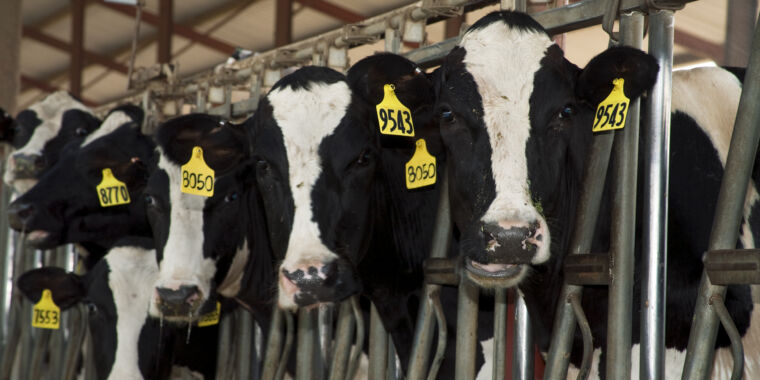A dairy farm worker in Michigan has tested positive for an H5 bird flu virus, marking the second human case of bird flu that has been linked to the unprecedented outbreak of highly pathogenic avian influenza H5N1 virus among dairy cows in the US.
According to the Centers for Disease Control and Prevention, the worker only experienced a mild eye infection and has since recovered, much like the first case in a dairy farm worker in Texas. The Michigan worker was being monitored for symptoms due to exposure—the person worked on a dairy farm with H5N1-infected cattle.
In a press briefing Wednesday afternoon, CDC Principal Deputy Director Nirav Shah said the person was taking part in an active surveillance system, in which the state’s health department sent out a text message every day asking about the presence of any symptoms. The worker’s infection was identified after the person responded that there were symptoms.
Health officials took swabs of the worker’s nose and eye. The CDC, which received the swabs for testing on Tuesday, confirmed that day that the nasal swab was negative while the eye swab was positive.
“We found this case because we were looking for this case,” Shah said, emphasizing that the CDC and Michigan had been prepared to find the additional human case and expected it.
In a separate statement, Natasha Bagdasarian, Michigan’s chief medical executive, emphasized that the state has been tracking the situation closely. “The current health risk to the general public remains low. This virus is being closely monitored, and we have not seen signs of sustained human-to-human transmission at this point. This is exactly how public health is meant to work, in early detection and monitoring of new and emerging illnesses.”
The CDC also said that its risk assessment for the general public remains low. However, the agency added that the infection underscores the risks and needed precautions for people exposed to infected or potentially infected animals.
It’s unclear how the worker became infected, but the CDC suspects that the person either got raw milk splashed in their eye or rubbed their eyes with contaminated hands. Raw milk from infected cattle has been found to carry extremely high levels of H5N1. It’s unclear at this point if the person had access to personal protective equipment, such as a face shield, which the federal government has been working to distribute.
For now, the testing by the CDC has only confirmed that the worker has an H5-type influenza infection. Further testing that can type the virus as H5N1, specifically, has not yet been completed. The CDC expects to have genetic sequencing of the virus available in one to two days. At that point, researchers can assess if the virus is the same as what’s been seen in cows and if it has acquired any worrying mutations that may allow it to spread more easily among humans.
With each new infection, H5N1 has the ability to adapt to new hosts, and experts are anxiously monitoring the outbreak in dairy cows—which was first detected in March—for signs that the virus will gain the ability to spark an outbreak in humans. Dawn O’Connell, assistant secretary for Preparedness and Response within the US Department of Health and Human Services, said in the press briefing Wednesday that, as a precaution, the federal government is moving to finish production of 4.8 million doses of H5N1 vaccine that is well-matched the virus seen circulating in dairy cows.
To date, the US Department of Agriculture has recorded 52 dairy cow herds have been infected with H5N1 across nine states. Michigan has reported 19 infected herds.
This post has been updated to include new information from today’s press briefing and statements.

Rachel Carter is a health and wellness expert dedicated to helping readers lead healthier lives. With a background in nutrition, she offers evidence-based advice on fitness, nutrition, and mental well-being.








